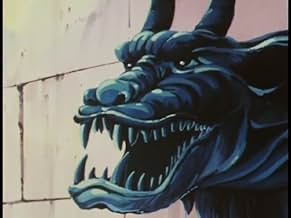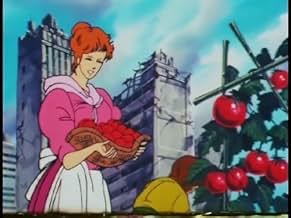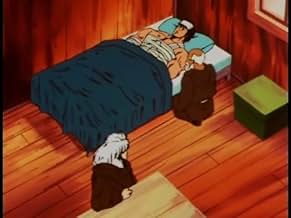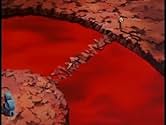VALUTAZIONE IMDb
8,1/10
3995
LA TUA VALUTAZIONE
Scomparso anni prima, Kenshiro torna per aiutare i suoi vecchi amici Lin e Bat ad affrontare una serie di nuove minacce, tra cui i maestri di «Gento Koken» e «Hokuto Ryuken».Scomparso anni prima, Kenshiro torna per aiutare i suoi vecchi amici Lin e Bat ad affrontare una serie di nuove minacce, tra cui i maestri di «Gento Koken» e «Hokuto Ryuken».Scomparso anni prima, Kenshiro torna per aiutare i suoi vecchi amici Lin e Bat ad affrontare una serie di nuove minacce, tra cui i maestri di «Gento Koken» e «Hokuto Ryuken».
Sfoglia gli episodi
Recensioni in evidenza
Wow....just finished the 109 episodes ; this story in not only amazing by its dept and maturity make it one of the best manga that I ever seen.
I recommand that you look at this serie before anything else of the Hokuto.
I recommand that you look at this serie before anything else of the Hokuto.
The characters aren't mutated warriors like that other fellow said (at least not in the original japanese version). These people are extremely gifted martial artists. Kenshirô, the main character, is a master assassin and the next in line to take over the Hokuto shin ken art. As Ken is chosen to be the master of the art by his teacher, his older school brothers (mainly the menacing Rao) are outraged by this and choose to violently leave the order, killing their teacher in the process. Keep in mind that only one master can be chosen and the rest of the students must either have their memories erased or their ken (fists) destroyed. Apparently the art is only meant for the best warrior and no internal struggle must persist. The character, Shin is a master of the Nanto sei ken (south fist or something like that). He is the first of four other nanto masters who will confront Ken.
Anywho, one can describe Kenshirô as a mix of Mad Max and Bruce Lee with a Road Warrior/kung fu/samurai flick backdrop. The series goes on as Ken battles his brothers, the nanto masters, and a bunch of other freaks with some flash backs here and there to help explain the story. The great thing about this series are the characters. They're not just evil dudes who kill kill and kill. Not only are they extremely colorful, they all have their reasons for their actions. You'll find that most of the major villains are regarded as heroes by the end.
Because this series is based on a comic book, you can expect to find some glitchy plot holes. But don't worry, the characters and the action are enough to make you forget about these plot holes.
Anywho, one can describe Kenshirô as a mix of Mad Max and Bruce Lee with a Road Warrior/kung fu/samurai flick backdrop. The series goes on as Ken battles his brothers, the nanto masters, and a bunch of other freaks with some flash backs here and there to help explain the story. The great thing about this series are the characters. They're not just evil dudes who kill kill and kill. Not only are they extremely colorful, they all have their reasons for their actions. You'll find that most of the major villains are regarded as heroes by the end.
Because this series is based on a comic book, you can expect to find some glitchy plot holes. But don't worry, the characters and the action are enough to make you forget about these plot holes.
"Hokuto no Ken" ("Fist of the North Star," 1984) took its cue from the Australian movies, MAD MAX (1979) and THE ROAD WARRIOR (aka MAD MAX 2, 1981), and pioneered a new style of violent animated action on Japanese television. It presented a more exaggerated version of the movies' post-apocalyptic landscape and its roving bands of savage bikers with Mohawk haircuts, spiked leather and bulging muscles who ravage the budding communities trying to rebuild society in a bleak and devastated terrain. Into the role of defender of the weak steps Ken, master of Hoto Shin Ken, or Fist of the North star, an intricate martial arts system that wreaks havoc on his opponents' nervous systems and causes all kinds of fatal disfigurements, usually an exploding decapitation. The stoic, deadpan Ken brooks no argument with those who offend him and spends most of the series ridding the landscape of these musclebound cretins. To balance out the constant violence with regular doses of sentiment, Ken's empathetic qualities are drawn out by the presence of two children, an adolescent harmonica-playing boy and a young girl saddled with a puppy, who become Ken's companions for much of the series.
While the violence is quite gruesome, the gore is muted by depicting the exploding heads in silhouette or shadow and having the spurting body fluids colored neutral hues. The carnage is, nevertheless, particularly satisfying because we get to watch dozens of murderous thugs get wasted, one by one, in colorful and imaginative ways. (The 1986 animated feature version of this series, also called FIST OF THE NORTH STAR, was much more explicit in its bloodshed.)
The first series lasted for 109 episodes, from 1984 to 1987, while a second series (1987-88) lasted 43 episodes. A number of episodes from the first season have been released in the U.S. and include the first story arc (22 episodes), which involves Ken's quest for vengeance against Shin, his one-time buddy and master of the Fist of the Southern Cross, who took Ken's girl away from him--by force--and left him with a seven-mark scar in the form of Ursa Major, the Big Dipper (or Great Bear) constellation. The second story arc gave Ken a new and equally formidable opponent in Raoh, master of Nanto Suichoken, a technique which literally slices opponents into pieces.
The animation does an expert job of recreating the stark imagery of the original manga (comic book), which was written by "Buronson" and drawn by Tetsuo Hara, capturing the near-desert landscape and spectacular urban ruins in evocative detail. The character design is equally well-etched, with great linework applied to even the most transient characters. Color is used well in both the parched quality of the arid landscape and the flamboyant nature of the rampaging biker gangs with their clown makeup and playing card gang motifs. There's a wash quality, suggesting water colors, in some of the background art. It should be pointed out that the hard-edged look and tone of the series is something traditional pen-and-ink animation could do so well but is much harder to achieve in the overly slick digital animation era in which anime finds itself today. A series like FIST is more to be valued because of the near impossibility of duplicating such an effort today.
While the violence is quite gruesome, the gore is muted by depicting the exploding heads in silhouette or shadow and having the spurting body fluids colored neutral hues. The carnage is, nevertheless, particularly satisfying because we get to watch dozens of murderous thugs get wasted, one by one, in colorful and imaginative ways. (The 1986 animated feature version of this series, also called FIST OF THE NORTH STAR, was much more explicit in its bloodshed.)
The first series lasted for 109 episodes, from 1984 to 1987, while a second series (1987-88) lasted 43 episodes. A number of episodes from the first season have been released in the U.S. and include the first story arc (22 episodes), which involves Ken's quest for vengeance against Shin, his one-time buddy and master of the Fist of the Southern Cross, who took Ken's girl away from him--by force--and left him with a seven-mark scar in the form of Ursa Major, the Big Dipper (or Great Bear) constellation. The second story arc gave Ken a new and equally formidable opponent in Raoh, master of Nanto Suichoken, a technique which literally slices opponents into pieces.
The animation does an expert job of recreating the stark imagery of the original manga (comic book), which was written by "Buronson" and drawn by Tetsuo Hara, capturing the near-desert landscape and spectacular urban ruins in evocative detail. The character design is equally well-etched, with great linework applied to even the most transient characters. Color is used well in both the parched quality of the arid landscape and the flamboyant nature of the rampaging biker gangs with their clown makeup and playing card gang motifs. There's a wash quality, suggesting water colors, in some of the background art. It should be pointed out that the hard-edged look and tone of the series is something traditional pen-and-ink animation could do so well but is much harder to achieve in the overly slick digital animation era in which anime finds itself today. A series like FIST is more to be valued because of the near impossibility of duplicating such an effort today.
This show is so badass it makes your beard sprout biceps it's like Dragonball z, Jojos bizarre adventure, and one punch man before those even existed. The mad max setting only adds to the coolness factor along with very badass villain designs like Roah or Jagi if you wanna watch manime watch this along with JoJo, Baki, and Berserk
WW3 has come & gone. The world lay ravaged, raped by mankind & its wars. Humanity must battle & survive the attacks of the mutated & horrid outlaws of the "new" world. One man armed with only a fighting man's knowledge that even puts "kebono-oko" or "kame-senin" to shame beyond belief. Hokuto Shin Ken [North Dipper Godfist]a powerful ancient age old (2000 yr) martial art passed only from father to son(s). The hero of this tale drenched in blood & honor, is Kenshirou Kasumi the 64th successor to Hokuto Shin Ken. In this tale the kind hearted Ken & his love Yulia were attacked by his former friend Shin of the opposite style of Nanto Sei Ken [South Dipper Sacred Fist] who is hell bent on taking the lovely girl. Yulia is stolen by Shin & Ken is left with seven scars in the shape of the Big Dipper on his chest. Ken's sole goal is to defeate Shin, but finds this adventure leads down a winding path to the death of his friends, family conflict, more & more death, & the loss of his true love. This anime has much social context & then some worth checking out especially if you are a fan of fighting series. Though this isnt DBZ/GT it is a good & to me a better series sticking to the point & what the show was about Ken, the soveriegn Fist of the North Star & how a man's yearn for love will take him to hell & back. "Give the devil my regards"-Kenshirou
Lo sapevi?
- QuizThe Internet memes, "Omae wa mou shinderu", literally meaning "You are already dead", and "Nani" meaning "What" emerged to the non-Japanese world.
- Versioni alternativeThe first four episodes were released edited together as a movie in Sweden.
- ConnessioniFeatured in Club Dorothée: Episodio datato 22 marzo 1989 (1989)
I più visti
Accedi per valutare e creare un elenco di titoli salvati per ottenere consigli personalizzati
Dettagli
- Data di uscita
- Paese di origine
- Sito ufficiale
- Lingua
- Celebre anche come
- Ken il guerriero
- Aziende produttrici
- Vedi altri crediti dell’azienda su IMDbPro
- Tempo di esecuzione
- 25min
- Colore
Contribuisci a questa pagina
Suggerisci una modifica o aggiungi i contenuti mancanti
































